Tools needed:
- ruler
- electric drill and various bits (3/32 in., 7/64 in., 1/8 in., 13/64 in., 9/32 in.)
- small flat screwdriver
- small pliers
- pocket knife or Xacto knife
- crayon or Sharpie
Neaten printed parts
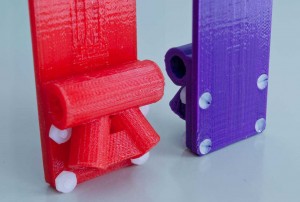
- Clean any plastic support structures or rough spots from pieces so they fit together well and the screw holes are clear. This (and the steps below) might be done already.
- Cut off the small square tabs at the ends of the upper frame arms.
- The top bracket on the upper frame will have support structures which can be removed. The hole through the cylinder can be drilled with a 9/32 in. bit, but don’t enlarge the hole.
Attach leg brackets to upper frame
- Fasten four nylon screws and bolts as shown. Tighten firmly, but take care not to strip the nylon threads. The uppermost nuts can be a tight fit, and it might help to cut a bit off two of the nut’s corners with a sharp blade.
Drill camera tray for tripod screw
The goal is to fasten the camera to the tray with its back snug along one of the tray’s lips and its center of mass centered along the long axis of the tray. This is the only really difficult thing that is easy to do wrong. Almost every camera will require a hole drilled in a different location. The standard camera trays have lips on both sides, so you get two chances to get the hole drilled correctly (or you can have holes for different cameras on either side). Materials: camera tray, tripod thumb screw, camera.
- Mark the lengthwise position of the tripod screw hole.
- Lay the camera (with batteries inserted) on its back on a pencil or crayon to determine its center of mass along its long axis. Mark the center on the back of the camera (e.g., with a crayon).
- Mark the position of the tripod socket on the back of the camera (e.g., with crayon).
- Measure and mark the center of the camera tray’s long axis (e.g., with crayon).
- Align the camera on the tray so its center of mass is at the center of the tray’s long axis, and mark on the tray the horizontal location of the tripod socket.
- Mark the front-back position of the tripod screw hole.
- Measure the distance from the center of the camera’s tripod socket to the back of the camera body. If the lower part of the camera is rounded, measure to the place the camera touches the tray lip when in position.
- Measure on the top of the camera tray this distance (1) from the inside of the lip to where the center of the tripod hole should be. Mark the spot on the tray where the lengthwise and front-back position of the tripod socket meet. Mark it with a large plus so it remains visible after drilling starts.
- Scratch a lead hole with a knife to get the drill bit started.
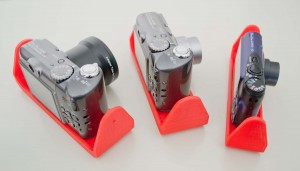
The camera should be mounted with its back edge firmly against the tray lip.
- Drill the hole for the tripod screw.
- Drill a hole with a small bit (~1/8 in.). The plastic has a low melting point and will soften quickly during high speed drilling. Drill carefully because the bit will start to “swim” through the plastic when it gets warm.
- Enlarge the hole with the 1/8 in. bit and cut away any melted plastic. Place the camera in position on the tray an look through the new hole into the tripod socket. If it looks like it is close, proceed.
- Enlarge the hole with a 13/64 in. bit. Clean up the hole and check again that it is properly aligned by sighting through it from the bottom into the camera’s tripod socket.
- Enlarge the hole until it is almost 1/4 in. diameter. The plastic is soft enough that this can be done with the 13/64 in. bit and you can carve the hole closer or farther from the lip so the camera will be snug against the lip when it is screwed on.
- Try to insert the tripod thumb screw into the hole. The thumb screw must turn freely in the hole before you try to thread it into the camera or you risk stripping the threads in the camera’s tripod socket. Ideally, the screw will thread itself through the plastic, but then turn freely when it is all the way in. This will strip the threads you just made, but the screw will stay inserted in the tray when the camera is not attached. If the hole gets too big for this, that’s okay.
- If the camera mounts too far from the lip, enlarge the hole so the camera can be screwed on snug against the lip. This is important so the camera cannot rotate and begin to loosen the thumb screw (bad thing for flying cameras, but the camera’s wrist strap or other lanyard should always be looped around the upper frame for safety).
- If the hole gets too big to hold the thumb screw, you can make the hole smaller by melting some PLA with a soldering iron and adding material to the inside of the hole. If you find a random piece of plastic with your rig parts, use that.
Attach camera tray to upper frame
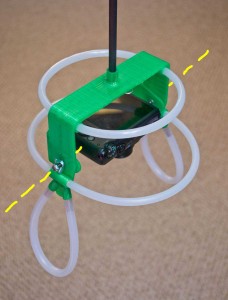
All camera trays and upper frames now have bolt holes for attaching them together. These holes allow most small cameras to be well balanced. Skip to step 3 below to assemble the rig with the existing holes. If your camera does not balance well, follow the instructions in steps 1 and 2 below for drilling new holes.
The goal is to mount the camera tray so that it tilts on the axis of the camera’s center of mass. This way the camera is balanced regardless of its tilt angle. This is important to make it easy to adjust the camera angle for vertical mapping, and to minimize rotational stress on the tray connections when the camera is aimed vertically. So the holes in the sides of the camera tray should be about halfway up the camera’s height. Materials: camera tray, upper frame, camera, two sets of 3/4 in. thumb screw, wing nut, lock nut, lock washer, and flat washer.
- Drill holes through each side of the camera tray at the height of the camera’s center of mass.
- The center of mass of most Canon PowerShots is about halfway up the camera, but you can confirm this by balancing the camera on a pencil or crayon. Mark the center height point on the camera (e.g., with a crayon).
- With the camera sitting on the camera tray, mark the sides of the tray with this height. The sides of the tray will be drilled from the outside, so this mark has to be transferred to the outer surfaces of both tray sides. For small cameras this may appear to be too low on the tray side, but that’s where the hole should be to ensure balance. Make sure the height is exactly the same on both sides of the tray (measure down from the top).
- Use a ruler to measure the width of the tray side at the height of the mark, and mark the center point for the hole. Make a large plus so that it remains visible after drilling begins. Scratch a lead hole to get the drill bit started.
- Drill a lead hole with a small bit (e.g., 3/32 in.). Be prepared for the bit to swim through soft plastic. Although the interior of much of the camera tray is a lightweight honeycomb of plastic, there is a solid pad where the hole should be drilled.
- Enlarge the hole with a 1/8 in. bit. Clean away the excess plastic and see if the 3/4 in. thumb screw passes through easily. It should turn freely.
- Drill the matching holes through both arms of the upper frame.
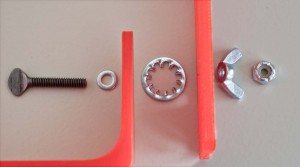
The large toothed lock washer goes between the camera tray and the upper frame. The wing nut and lock nut go on the outside of the frame. - The matching holes through the upper frame should be in the center of the frame (front to back) and about 1/2 in. above the top of the leg brackets (just high enough so the wingnut can turn) . Mark this spot on the outside of the frame and drill as above. The thumb screw should pass through easily. Make sure the height is exactly the same on both arms of the frame (measure from the bottom).
- Attach camera tray to upper frame.
- Attach the hardware as shown. The nylon insert lock nut should be threaded onto the end of the thumb screw just far enough so the screw end is flush with the outside of the nut. It ensures that the wing nut cannot come off if it becomes loose.
- When assembled correctly with the large lock washer between the upper frame and tray, the wing nut can be tightened by hand so that the weight of the camera will not change the angle of the camera tray. Do not try to rotate the tray when the wing nut is tight, loosen it first.
- The wide camera trays have a choice of three holes for the thumb screw. Use the one which allows your camera to balance best.
Configuring legs and bumpers
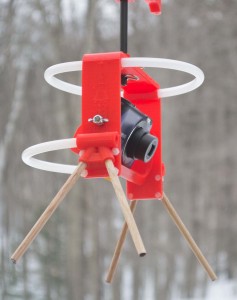
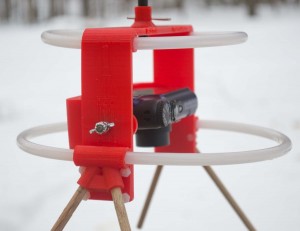
The traditional configuration is with four legs which protect the camera from dirt and wet grass during setup and against hard landings. Additional camera protection can be added by attaching loops of polyethylene tubing. Many configurations are possible with the included tubing.
- If required cut the 1/4 in. oak dowels into 12 cm long pieces. A hacksaw works well.
- Use a blade to clean the inside edges of the ends of the angled leg bracket tubes. Insert the dowels into the brackets and twist them in. If the dowels are too tight the brackets can be reamed with a 1/4 in. drill bit. Use caution if drilling the leg bracket — a drill bit can pull itself in quickly. If the dowels fit loosely, they could fall out in flight — go to plan B (currently not defined, so don’t enlarge the brackets too much).
- If required, cut polyethylene tubing to the correct lengths for bumpers (see parts list). A sharp Xacto knife works well. There are two sizes of tubing — the thicker one is only for leg loops to replace the oak dowel legs.
- The 5/16 in. tubing (the narrower size) should slide through the horizontal plastic tubes with concerted effort. If the fit is too tight, use a 9/32 in. bit to ream the holes a bit. It is good to have a tight fit.
- Where the ends of a loop of tubing meet inside a horizontal plastic tube, insert a 1 inch (2.5 cm) piece of white plastic (acetal) rod in the ends to join the tubing more securely.
- To attach tubing loops instead of oak legs, insert a 1 inch (2.5 cm) piece of 1/4 in. oak dowel (as above in #2) into each angled leg bracket, then slide on the ends of a 26 cm long piece of 3/8 in. tubing. The tubing loops are better for balloon photography because they avoid hooking the vertical balloon line better than straight legs.
- For oblique photography, the lower horizontal bumper might be in the field of view. Therefore it is convenient to make that bumper from two pieces of tubing so half of it can be removed to clear the view for the camera. One inch pieces of white plastic can join the two tubing pieces inside the plastic tubes.
Attaching the rig to a suspension system

The shaft for a Picavet or pendulum suspension can be inserted into the vertical bracket at the top of the frame. A single hole should be drilled through the side of the plastic tube for a cotter pin. This hole is already present, but might need to be made larger.
- Drill a 7/64 in. hole horizontally just above the collet at the base of the plastic tube. The hole should pass through the exact center of the tube. The angle is important so the cotter pin can pass through the hole in the inserted shaft.
- If the shaft from the suspension is too tight, smooth the upper and lower ends of the plastic bracket tube with a blade or ream the hole with a 9/32 in. drill bit.
- Always insert a second cotter pin below the frame.
Safe flying
- Always secure the camera to the Redstone Rig with a lanyard. The wrist strap on point & shoot cameras works well for this.
